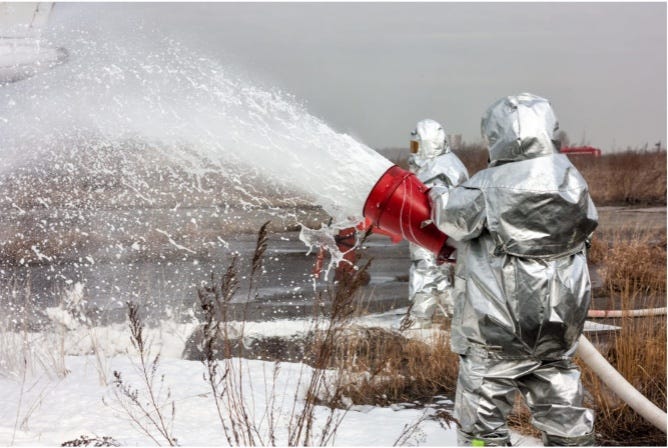Wednesday's postcard, and the state's wake up call for Spokane International Airport's water pollution problem
August 23, 2023
“The Sky Above Road H” in Douglas County
Time’s Up
When last we visited the less-than-forthright manner in which the Spokane International Airport (SIA) suppressed its discovery of highly toxic chemicals in its groundwater, the Washington Department of Ecology had sent a terse letter notifying SIA that it was a “potentially liable party” under the state’s toxic waste law. The July 6th letter noted that SIA managers had not reported the pollution—as state law requires—and it gave airport officials thirty days to respond.
Last week, the word “potentially” was effectively removed, and the state formally notified SIA that it is simply a “liable party” responsible for remediating the contamination. That news was delivered in an August 17th letter to SIA from Nicholas Acklam, the Toxics Cleanup section manager in Ecology’s Eastern Regional Office.
Although the letter continues to refer to SIA as a “PLP,” Acklam made clear in an interview yesterday that Ecology is moving forward with the “liable party” designation for SIA. He says the agency will soon engage SIA to help develop a plan and timeline for mandatory site investigation and the development of a binding cleanup plan. In the interview Acklam also disclosed that SIA had contested its designation as a PLP and was “upset that Ecology had not taken a more collaborative tone” in its communication with SIA officials.
The contamination at issue is PFAS—a suite of so-called “forever chemicals” that has emerged as one of the nation’s most serious water pollution problems due to its longevity, ubiquity and toxicity. It is prevalent in groundwater on the high plains west of Spokane and linked to the use of Aqueous Film Forming Foam (AFFF)—a fire retardant developed by the U.S. Navy in partnership with the 3M company. It was marketed to air bases and airports for nearly a half century.
AFFF is rich in PFAS chemicals which were detected at Fairchild Air Force Base in 2017 and shortly thereafter found, at high levels, in nearby groundwater including water being pumped to supply the City of Airway Heights. In 2019 the federal Agency for Toxic Substances and Disease Registry released a study showing high levels of PFAS in the bloodstreams of Airway Heights residents who’d been ingesting the tainted water.
Until Ecology released its July 6th letter it was clear that SIA’s neighbor—Fairchild Air Force Base—was taking the brunt of responsibility and criticism for the whole of the PFAS groundwater contamination problem on the West Plains. (The two airports are only four miles apart, and PFAS contamination has now been detected in wells at least 6 miles from both airfields.)
One difference is what while officials at FAFB reported the contamination and moved quickly to provide filtration systems or bottled water to private well owners, SIA remained silent about the contamination it discovered in 2017 and corroborated with additional well sampling in 2019.
On July 18th I sent SIA a public records request for any records that—
• SIA officials notified local, state, or federal officials about the presence of PFAS contamination at SIA,
• show that such disclosure(s) were received,
•contain communications within the SIA management, including its board, discussing disclosure of the PFAS contamination and how to respond to it,
•convey communications between SIA officials and SIA board members pertaining to the presence, or suspected presence of PFAS chemicals in groundwater at SIA.
Late yesterday (August 22) I received an email from SIA’s General Counsel, Brian Werst, informing me SIA has not found any such records.
Certainly one of the questions raised by SIA’s years-long silence is whether the state will seek civil penalties for non-disclosure. Under the state’s hazardous waste laws, owner/operators have 90 days to report environmental releases that may pose a threat to public health and the environment. Penalties can run up to $10,000 per day.
What may save SIA from sanctions for non-disclosure is that—on both national and state levels—there were no formal regulatory standards for PFAS chemicals at the time the airport detected them in 2017 and 2019. The state has subsequently issued “state action levels” that went into effect in January of 2022. But the U.S. EPA has still not finalized standards for drinking water.
Acklam says Ecology’s present focus is on remediation and that the state would likely be “reluctant to go down that road” (toward civil penalties) given the long, complex process of putting in place state and federal regulatory thresholds for the broad suite of PFAS chemicals. His August 17th letter did, however, warn of the potential for $25,000 per day fines if SIA fails to comply with future Ecology orders related to the cleanup of the contamination at the airport.
Although both Ecology letters are in public domain, the SIA letter responding to Ecology’s July 6th notification is being withheld by Ecology. (I’ve also requested the letter and invited comment from SIA, but thus far without response.)
What Ecology did release in response to my records request was an August 7th cover slip conveying SIA’s response. The subject line on the cover slip was: “Confidential settlement discussion correspondence from Spokane International Airport.” The cover slip also contained a note from the Washington D.C. law office representing SIA conveying an offer to meet with Ecology officials to “discuss these matters further to find collaborative solutions.”
I have lodged a protest with Ecology for withholding SIA’s response, which the agency says it will withhold at least until September 8th. Acklam indicated the use of the word “confidential” in the cover slip is what slowed the release down; that while Ecology has rejected SIA’s request to enter into confidential negotiations, the agency believes it is obligated to give SIA sufficient time to appeal that decision, and that the requested SIA letter can be withheld in the meantime.
—tjc







